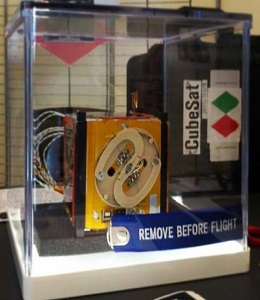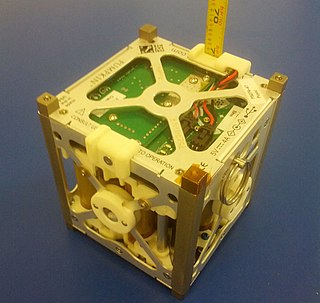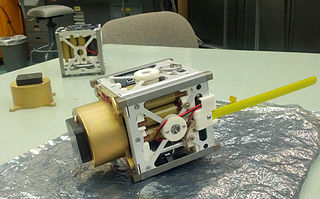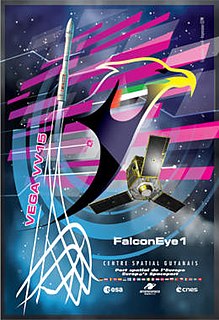
Vega is an expendable launch system in use by Arianespace jointly developed by the Italian Space Agency (ASI) and the European Space Agency (ESA). Development began in 1998 and the first launch took place from the Centre Spatial Guyanais on 13 February 2012.

e-st@r is a miniaturised satellite built by the Politecnico di Torino. It is a 1U CubeSat design with a 10 cm side and a mass not exceeding 1.33 kg.
UniCubeSat-GG is a Miniaturized satellite built by the Sapienza University of Rome. It was launched into Low Earth Orbit on the maiden flight of Arianespace's Vega rocket on 13 February 2012. The launch was a multi-payload mission shared with LARES, ALMASat-1, Goliat, MaSat-1, PW-Sat, ROBUSTA, e-st@r and Xatcobeo.

ESTCube-1 is the first Estonian satellite and first satellite in the world to attempt to use an electric solar wind sail (E-sail). It was launched on 7 May 2013 aboard Vega VV02 carrier rocket and successfully deployed into orbit. The CubeSat standard for nanosatellites was followed during the engineering of ESTCube-1, resulting in a 10×10×11.35 cm cube, with a volume of 1 liter and a mass of 1.048 kg.

Alexander, also known as PhoneSat 2.0 Beta or PhoneSat v2a is a technology demonstration satellite operated by NASA's Ames Research Center, which was launched in April 2013. Part of the PhoneSat programme, it was one of the first three PhoneSat spacecraft, and the first Phonesat-2.0 satellite, to be launched.

Graham, also known as PhoneSat 1.0a or PhoneSat v1a was a technology demonstration satellite operated by NASA's Ames Research Center, which was launched in April 2013. Part of the PhoneSat programme, it was one of the first three PhoneSat spacecraft to be launched.

Bell, also known as PhoneSat 1.0b or PhoneSat v1b was a technology demonstration satellite operated by NASA's Ames Research Center, which was launched in April 2013. Part of the PhoneSat programme, it was one of the first three PhoneSat spacecraft to be launched.
SHERPA is a commercial satellite dispenser developed by Andrews Space, a subsidiary of Spaceflight Industries, and was unveiled in 2012. The maiden flight was on 3 December 2018 on a Falcon 9 Block 5 rocket, and it consisted of two separate unpropelled variants of the dispenser.
ArgoMoon is a CubeSat that will launch into a heliocentric orbit on Artemis 1, the maiden flight of the Space Launch System. The objective of the ArgoMoon spacecraft is to take detailed images of the Interim Cryogenic Propulsion Stage following Orion separation, an operation that will demonstrate the ability of a cubesat to conduct precise proximity maneuvers in deep space.

Vega flight VV02 was the second flight of the Vega launcher. It occurred from the Guiana Space Centre on 7 May 2013 at 02:06:31 UTC.

Vega flight VV03 is the third flight of the Vega launcher. It occurred from the Guiana Space Centre on 30 April 2014 at 01:35:15 UTC.

Vega flight VV05 is the Vega space launch of the Sentinel-2A satellite.

Vega flight VV07 is the 7th Vega space launch, of the PerúSAT-1 and 4 SkySat satellites.

Vega flight VV15 was the 15th flight of the Vega launcher, and its first failure.

Vega flight VV12 was the launch of the ADM-Aeolus satellite by the 12th Vega launcher.

Vega flight VV16, also called SSMS PoC Flight, was the 16th launch of the Vega rocket. The launch was also notable as it was the first Vega launch following the accident of the VV15 launch in July 2019 that caused the loss of FalconEye1 satellite.
PhiSat-1 is a CubeSat mission from the European Space Agency (ESA) that uses Artificial Intelligence (AI) for Earth observation. The mission will collect a large number images from space in the visible, near-infrared and thermal-infrared parts of the electromagnetic spectrum, and then filter out the images which are covered with clouds using AI algorithms. This reduces the number of images to be downlinked from space and therefore improve efficiency. The PhiSat-1 mission has two main objectives:

Vega flight VV19 was the 19th launch of the Vega rocket.















